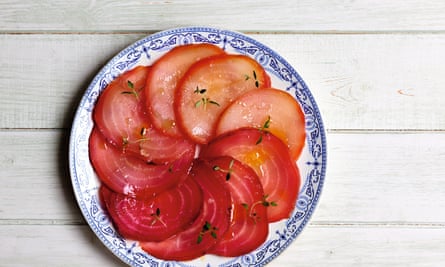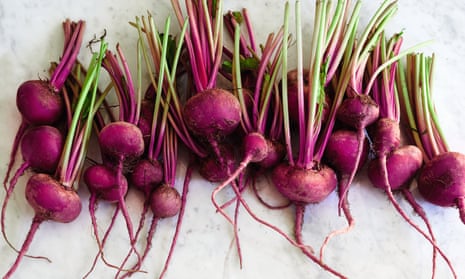I blame Mr McGregor. From childhood, we’ve been pre-conditioned to view the kitchen garden as an immaculate walled Eden, fecund and perfect in a way us mere mortals could never hope to achieve. No wonder Peter Rabbit decided to bust in there –perhaps he, too, was residing in a one-bedroomed flat in Brentford, just a square foot of paving slabs to his name.
The Guardian’s product and service reviews are independent and are in no way influenced by any advertiser or commercial initiative. We will earn a commission from the retailer if you buy something through an affiliate link. Learn more.
Luckily, though, the modern kitchen garden requires little space, time or prior experience to create. In fact, the following herbs, salad, vegetables and fruit are so simple and low-maintenance to grow that the total beginner will look like Monty Don in no time (braces not compulsory). Planting in containers is a quick, easy, space-saving approach.
The effect of growing your own ingredients on how you cook is profound. I’m not a vegetarian by any stretch of the imagination, but the unexpected joy of learning how to garden has taught me a newfound respect for the humble veg. Your first weirdo malformed strawberry. Your inaugural shoot of neon chard. This is food to be celebrated, brought front and centre on the menu, and shared.
For the most part, we’ll be growing outside – a wide doorstep, a tiny balcony, or minuscule patio is all you need; however, even if all you have is a single sunny indoor windowsill, our first plant, chives, will be perfectly happy in your home.
Before we begin
Aside from chives (which are easy), we’ll be starting from seedlings – the young plants found in the “grow your own” section of your local garden centre or DIY superstore. When you’re just starting out, there’s enough to learn without adding seeds into the mix.
Line your plant containers with a layer of gravel, broken pots or the like to help drainage, then fill them with a good sustainable potting compost – handily, this is available at the same shops as your seedlings and seeds.
Water seedlings before planting, then again after they’re planted. A small fine-headed watering can is all you need.
Chives and rainbow chard can be planted this weekend. Strawberries can be planted next month, and beetroot the next. So that’s your spring planting sorted.
Chives
The perfect place to start: all you need is a sunny windowsill and an optimistic nature. Fresh chopped chives are a scatterer’s dream, but their edible purple flowers are the real reason to grow this fragrant, oniony herb.
To grow:
Sow seeds March–June
Where A window box or small pot in a sunny spot. If growing indoors, position away from radiators and crack open the window now and then.
How Sow seeds lightly across the surface then cover with a thin layer of soil. Water lightly and regularly.
Harvest 2 months later. Cut as needed, leaving 5cm at the base to keep them growing back.
To cook:
Chive flower vinegar
The secret ingredient for the prettiest salad dressings known to Instagram. Fill half a sterilised jar with chive flower heads, top with white wine vinegar, shake, then store in a cool dark place for 1-2 weeks, when the vinegar will be a lovely light pink. Particularly splendid when used to make a delicate aioli-esque mayonnaise.
Rainbow chard
Thoroughly Michelin-starred in appearance, difficult to find in shops, yet absurdly easy to grow at home, rainbow chard is something you can plant this weekend.
To grow:
Plant seedlings March–July
Where In large pots and planters in a sunny sheltered spot
How Chard needs room (30cm at least), so no more than 1-2 per pot. In hot weather, water twice a day so they don’t dry out.
Harvest After 8-10 weeks, slicing them off a few centimetres from the base as needed.
To cook:
Rainbow eggs florentine
Instead of spinach, try this colourful take on the brunch classic. In a frying pan, soften 3 sliced garlic cloves with a little olive oil. Add the finely chopped stalks of a large handful of chard and cook for 1-2 minutes. Add the leaves and cook for 1 minute more. Carefully poach a couple of eggs. Spoon the chard mixture on to toasted muffins, top with an egg each, then pour over hollandaise and season.
Beetroot
A homegrown beetroot is a thing of earthy beauty, and an excellent example of “root to leaf” eating, its leaves making a delicious spinach substitute. Search online and you can find all sorts of interestingly coloured seedling varieties. Dobies.co.uk have a lovely looking “rainbow mix”.
To grow:
Plant seedlings May–July
Where In a large shallow container positioned in a sunny or partly sunny spot
How Plant 10cm apart. Beetroot hate being soggy, so rainfall will be enough most of the time; water every 10-14 days in a heatwave.
Harvest From 2 months onwards, depending on the variety – when their heads reach golf ball to tennis ball size.
To cook:
Salt-baked beetroot
Heat the oven to 160C/325F/gas mark 3. Pop your beetroot into a small ovenproof dish, and then tip in an entire box of flaky sea salt, entombing your beetroot. Bake for 45-60 minutes until just tender. Perfection when peeled, sliced and served with burrata.

Strawberries
AKA “pudding”. As luck would have it, the quintessential taste of British summer doesn’t need a garden at all. Pilfer an old wooden wine box from the local offy, pop it on a sunny outside step or ledge, and you’ll have a mini pick-your-own in no time.
To grow:
Plant seedlings April-May
Where In a wooden wine box in a warm sunny spot
How Drill holes in the bottom; add a little well-rotted manure to the compost. Plant strawberries 30cm apart. Once flowering, sprinkle with tomato feed every 10 days and keep well watered.
Harvest 4-6 weeks after blossoming. As soon as they turn red.
To cook:
Teeny tiny strawberry pavlovas
What if you only manage to grow 3 tiny strawberries? Adopt the Borrowers approach, and celebrate them as ludicrously tiny canapé desserts. St Delia’s meringue recipe is king, but ours should be spooned out to about 6cm in diameter, baked for 20 minutes, then cooled in the oven overnight. Top with clotted cream and a single strawberry.
- Hollie Newton is a writer, keen gardener and ‘creator of stuff’. Her new book, How to Grow (Orion), is out now; hollienewton.com

Comments (…)
Sign in or create your Guardian account to join the discussion